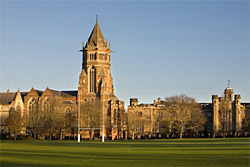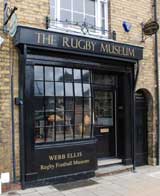Concluding my final part of a mini-series of travel blog articles on visiting Rugby, the birthplace of the game.
Continue reading “#RWC2015 – Eat, sleep, drink (in) Rugby: Part III”
Concluding my final part of a mini-series of travel blog articles on visiting Rugby, the birthplace of the game.
Continue reading “#RWC2015 – Eat, sleep, drink (in) Rugby: Part III”
Continuing on from my first blog post about Eat, sleep, drink (in) Rugby, here’s some top insider tips on the best places to eat, drink and be merry in the birthplace of the game.
Continue reading “#RWC2015 – Eat, sleep, drink (in) Rugby: Part II”
September signals the once-a-year chance to explore the world on your doorstep, unlocked and completely free of charge.
Today signals the start of Heritage Open Days which celebrates England’s wide array of culture and architecture by offering free access to places that are usually closed to the public or normally charge for admission.
Every year on four days in September, buildings, visitor attractions and other ‘hidden gems’ of a cultural significance of every age, style and function throw open their doors, for a once-a-year chance to discover architectural treasures and enjoy a wide range of tours, events and activities that bring local history and culture to life.
Local heritage – some of which you had probably forgotten about or taken for granted, or not even known was there, open and right on your doorstep.
And it goes further as September is a month of open days across Europe.
Heritage Open Days was established in 1994 as England’s contribution to the European Heritage Days, so 2014 marks the 20th anniversary.
The scheme was initiated in 1991 by the Council of Europe to raise appreciation for Europe’s rich and diverse cultural assets and their need for care and protection.
The principle behind it all was to simply throw open the doors to historic monuments and buildings, in particular those normally closed to the public. One of the key requirements was to offer free access to all properties taking part in the European Heritage Days.
In the UK, there are five open day schemes that are part of the wider European Heritage Days scheme across the continent, those being:
To find out more about what is on offer ‘on your doorstep’ so to speak, check out the Directory Map or get a printable guide list
As travel writer, and Editor and writer for a UK publisher with two magazines that focus on UK tourism (Discover Britain’s Gardens magazine, and Discover Britain for Groups magazine), this is right up my street.
However, the offering on my very own doorstep (Rugby, in Warwickshire) is slightly disappointing.
There are some great places to visit, don’t get me wrong such as Brownsover Hall, the Marton Museum of Country Bygones to name a couple.
but for the town which heralds as being the birthplace of the game, one would have thought this would [again] be a great opportunity to capitalise on this unique claim to fame, and offer local and visitors/tourists alike a chance to go behind-the-scenes.
Still, with the Rugby World Cup on these shores next year, you never know…
In the meantime, wherever you are, get out, enjoy and explore what’s on your doorstep whilst you have the chance to.
As someone who has a passing interest in all things heritage and historic, a now-annual event taking place today and over this weekend is always something to keep an eye out for.
Yet with Heritage Open Days weekend getting underway today, I cannot help thinking that locally Rugby has once again missed a trick.
If you haven’t heard of it, Heritage Open Days (HODs) is the once-a-year chance to explore the world on your doorstep – a point and reference I have brought up many times over the years in various conversations and articles.

HODs celebrates England’s fantastic architecture and culture by offering free access to places that are usually closed to the public or normally charge for admission. Every year on four days in September, buildings of every age, style and function throw open their doors providing chance to discover architectural treasures and enjoy a wide range of tours, events and activities that bring local history and culture to life.
HODs is organised by a huge network of people who share a passion for places, history and culture. Locally, over 1,400 organisations and some 40,000 volunteers organise thousands of site openings and events, jointly attracting over 1 million visitors, making it England’s biggest voluntary cultural event. On a national level, the programme is managed by the Heritage Open Days National Partnership and funded by English Heritage, and is all part of a wider programme and initiative across the British Isles and Europe. For example, there is Doors Open Days in Scotland, Open Doors Days in Wales, and European Heritage Open Days in Northern Ireland)
As someone who is involved professionally within travel and tourism – with one area more specifically within heritage tourism, Heritage Open Days is always of real interest to me.
And with various places I get to visit in my role, the one thing I notice is that any given destination or attraction all tend to draw on their strengthens and assets (i.e connections that may be historical, literary, maritime-related etc) as far as they can and to maximum effect.
And why not? If you have something great to shout about – and want visitors to come and find out more about it, do it. After all, the many reciprocal benefits that are generated as a result all prove the effort is worth it.
Yet when I look around at what doors are opening in my hometown (and base) of Rugby this coming HODs weekend, I can’t help thinking there is something glaringly missing.
Don’t get me wrong, the programme in and around Rugby itself and venues available to visit are great. There are many of the Rugby’s great historic churches, a Historic Buildings Walk, a Ranger-led tour of Draycote Water, trips on narrowboats, and talks about the town’s historic Caldecott Park; Plus – and I would highly recommend this, there is chance on Sunday to undertake a tour of Brownsover Hall Hotel to explore the grounds of the Victorian estate and visit the former office of Sir Frank Whittle, the inventor of the jet engine.
(although I’m not so sure on the heritage qualities of tours of the Cemex plant it has to be said – more of the PR exercise to be honest)


So a varied line-up, yet for a town which is unique for being the birthplace of rugby football and also having Rugby School at its very heart – both having such a huge historical significance behind them, one would have thought a bigger effort and campaign would be made by the likes of the local and county councils and Rugby School to really highlight the fact.

You could counter that Rugby School do offer guided tours all through the year and there is the Gilbert (now Webb Ellis) Museum, which is open to visit free of charge.
And plans are afoot apparently (and very much under close wraps) to showcase Rugby when the Rugby World Cup is held in the UK in 2015.

But with such a high profile weekend of history and heritage again in the public domain both locally, regionally and nationally, another unique opportunity to really showcase the unique worldwide assets the town of Rugby has for my mind been inextricably missed.